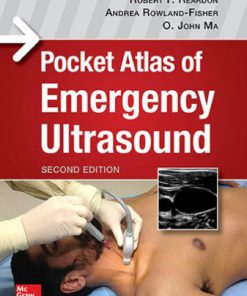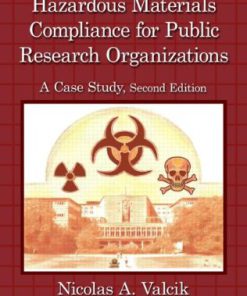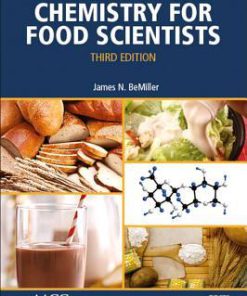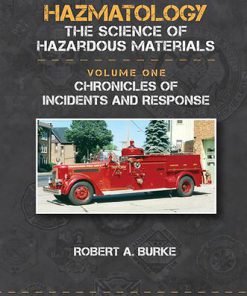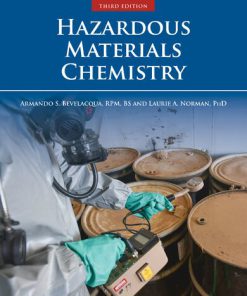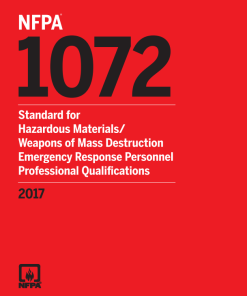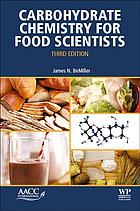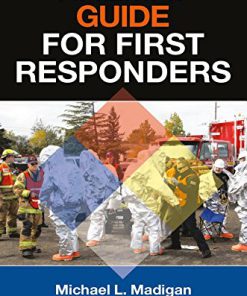Hazardous Materials Chemistry for Emergency Responders 3rd Edition by Robert Burke 1040069332 9781040069332
$50.00 Original price was: $50.00.$25.00Current price is: $25.00.
Hazardous Materials Chemistry for Emergency Responders 3rd Edition by Robert Burke – Ebook PDF Instant Download/DeliveryISBN: 1040069332, 9781040069332
Full download Hazardous Materials Chemistry for Emergency Responders 3rd Edition after payment.

Product details:
ISBN-10 : 1040069332
ISBN-13 : 9781040069332
Author: Robert Burke
The third edition of a bestseller, Hazardous Materials Chemistry for Emergency Responders continues to provide the fundamentals of “street chemistry” required by emergency response personnel. Emergency response and hazmat expert Robert Burke takes the basics of chemistry appropriate for response personnel and puts it into understandable terms. The
Hazardous Materials Chemistry for Emergency Responders 3rd Table of contents:
Chapter 1 Introduction
Hazardous materials statistics
Dot/Un hazard classes of hazardous materials
Nfpa 704 marking system
Health
Flammability
Reactivity (stability)
Chemical characteristic listings and incidents
Chemical and physical characteristics: Training competencies
Osha 1910.120
Operations level
Technician
Specialist
Awareness
Operations
Technician
Incident commander
Review questions
Chapter 2 Basics of chemistry
Periodic table of elements
Elements
Atomic number
Atomic weight
Hazmat elements
Hydrogen
History
Sources
Important compounds
Uses
Isotopes
Important reactions
Hazards to responders (Photo 2.2)
Lithium
History
Sources
Important compounds
Uses
Isotopes
Important reactions
Hazards to responders
Sodium
History
Sources
Important compounds
Uses
Isotopes
Hazards to responders
Potassium
History
Sources
Important compounds
Uses
Isotopes
Important reactions
Hazards to responders
Beryllium
History
Sources
Important compounds
Uses
Isotopes
Important reactions
Hazards to responders
Magnesium
History
Sources
Important compounds
Uses
Isotopes
Important reactions
Hazards to responders
Calcium
History
Sources
Important compounds
Uses
Isotopes
Important reactions
Hazards to responders
Barium
History
Sources
Important compounds
Uses
Isotopes
Important reactions
Hazards to responders
Titanium
History
Sources
Important compounds
Uses
Isotopes
Important reactions
Hazards to responders
Chromium
History
Sources
Important compounds
Uses
Important reactions
Hazards to responders
Manganese
History
Sources
Important compounds
Uses
Isotopes
Important reactions
Hazards to responders
Iron
History
Sources
Important compounds
Uses
Isotopes
Important reactions
Hazards to responders
Cobalt
History
Sources
Important compounds
Uses
Isotopes
Important reactions
Hazards to responders
Copper
History
Sources
Important compounds
Uses
Isotopes
Important reactions
Hazards to responders
Silver
History
Sources
Important compounds
Uses
Isotopes
Important reactions
Hazards to responders
Gold
History
Sources
Important compounds
Uses
Isotope
Important reactions
Hazards to responders
Zinc
History
Sources
Important compounds
Uses
Isotopes
Important reactions
Hazards to responders
Mercury
History
Sources
Important compounds
Uses
Isotopes
Important reactions
Hazards to responders
Boron
History
Sources
Important compounds
Uses
Isotopes
Important reactions
Hazards to responders
Aluminum
History
Sources
Important compounds
Uses
Isotopes
Important reactions
Hazards to responders
Carbon
History
Sources
Important compounds
Uses
Isotopes
Important reactions
Hazards to responders
Silicon
History
Sources
Important compounds
Uses
Isotopes
Important reactions
Hazards to responders
Nitrogen
History
Sources
Important compounds
Uses
Isotopes
Important reactions
Hazards to responders
Phosphorus
History
Sources
Important compounds
Uses
Isotopes
Important reactions
Hazards to responders
Arsenic
History
Sources
Important compounds
Uses
Isotopes
Important reactions
Hazards to responders
Plutonium
History
Sources
Important compounds
Uses
Isotopes
Important reactions
Hazards to responders
Oxygen
History
Sources
Important compounds
Uses
Isotopes
Important reactions
Hazards to responders
Sulfur
History
Sources
Important compounds
Uses
Isotopes
Important reactions
Hazards to responders
Fluorine
History
Sources
Important compounds
Uses
Isotopes
Important reactions
Chlorine
History
Sources
Important compounds
Uses
Isotopes
Important reactions
Hazards to responders
Bromine
History
Sources
Important compounds
Uses
Isotopes
Important reactions
Hazards to responders
Iodine
History
Sources
Important compounds
Uses
Isotopes
Important reactions
Hazards to responders
Uranium
History
Sources
Important compounds
Uses
Isotopes
Important reactions
Hazards to responders
Helium
History
Sources
Important compounds
Uses
Isotopes
Important reactions
Hazards to responders
Neon
History
Sources
Important compounds
Uses
Isotopes
Important reactions
Hazards to responders
Argon
History
Sources
Important compounds
Uses
Isotopes
Important reactions
Hazards to responders
Krypton
History
Sources
Important compounds
Uses
Isotopes
Important reactions
Hazards to responders
Xenon
History
Sources
Important compounds
Uses
Isotopes
Important reactions
Hazards to responders
Lead
History
Sources
Important compounds
Uses
Isotopes
Important reactions
Hazards to responders
Compounds and mixtures
Solubility
Atom
Formulae
Ionic bonding
Covalent bonding
Salts
Binary salts
Binary oxides (metal oxides)
Peroxide salts
Hydroxide salts
Complex ions (polyatomic)
Oxysalts
Cyanide salts
Ammonium salts
Inorganic nonsalts
Binary nonsalts
Nonmetal oxides
Binary acids (inorganic acids)
Oxyacids (inorganic acids)
Inorganic cyanides
Nonmetal compounds
Physical and chemical terms
Review questions
Chapter 3 Explosives
Definition of explosion
Categories of explosions
Phases of explosions
Mechanical overpressure explosions
Mechanical/chemical explosions
Chemical explosions
Dust explosions
Nuclear explosions
Components of a chemical explosion
Types of chemical explosives
Forbidden explosives for transportation
Types of chemical explosions
Explosive effects
Yield vs. order
Division 1.1-1.3 explosives
Explosive families of compounds
Inorganic explosive compounds
Metal azides
Aliphatic explosive compounds (nitro hydrocarbon derivatives)
Aromatic explosive compounds
Incidents
Explosives subclasses 1.4-1.6
Explosive chemicals
Incidents
Homemade explosives/terrorist explosives
Military explosives
Summary
Review questions
Chapter 4 Compressed gases
Flammable gases
Flammable range
Vapor density
Flammable gas elements
Hydrocarbon families
Alkanes
Isomers
Alkenes
Common alkenes
Alkynes
Hydrocarbon derivatives
Common hydrocarbon derivatives
Incidents
Nonflammable compressed gases
Mri and Nmr facilities
Hydrocarbon derivatives
Nonflammable gas compounds
Incidents
Poison gases
Incidents
Summary
Review questions
Chapter 5 Flammable liquids
Effects of temperature on flammable liquids
Boiling point
Factors affecting boiling point
Molecular weight
Polarity
Branching
Flash point
Ignition temperature
Flammable range
Vapor pressure
Vapor content
Vapor density
Specific gravity
Polymerization and plastics
Animal and vegetable oils
Fire-extinguishing agents
Hydrocarbons
Isomers
Cyclic alkanes
Hydrocarbon derivatives
Alkyl halide
Amines
Ethers
Alcohol
Isomers
Ketone
Aldehyde
Esters
Organic acids
Other flammable liquids
Incidents
Review questions
Chapter 6 Flammable solids
Class 4.1 flammable solids
Flash-point solids/sublimation
Flammable particles and dusts
Class 4.2 spontaneous combustibles
Pyrophoric solids and liquids
Incidents
Class 4.3 dangerous when wet
Incidents
Fire-extinguishing agents
Review questions
Chapter 7 Oxidizers
Class 5.1 oxidizers
Oxysalts
Peroxide salts
Inorganic acid oxidizers
Other oxidizer compounds
Incidents
Class 5.2 organic peroxides
Incident
Review questions
Chapter 8 Poisons
Types of exposure
Routes of exposure
Effects of exposure
Short-term effects
Long-term effects
Etiologic effects
Variables of toxic effects
Dose/response
Susceptible target organs
Exposure rate
Defense mechanisms for toxic materials
Toxic elements
Toxic salts
Toxic hydrocarbons
Toxic hydrocarbon derivatives
Alkyl halides
Amines
Cyanides and isocyanates
Alcohols
Aldehydes
Organic acids
Phosphoric esters
Miscellaneous toxic materials
Pesticides
Other toxic materials
Military and terrorist chemical agents
Chemical agents
Nerve agents
Antidotes
Mustard agents (vesicants)
Blood agents (cyanogens)
Choking agents (lung-damaging agents)
Riot-control agents (irritant agents and vomiting agents)
Vomiting agents
Miscellaneous chemical agents
Infectious substances
Bacterial agents
Viruses
Toxins
Chemistry of clandestine drug labs
Summary
Review questions
Chapter 9 Radioactive materials
History of radiation
Types of radiation
Isotopes
Regulation of radioactive materials
Intensity of radiation
Geiger counter
Lithium fluoride crystal
Bubble detector
Helium 3 detector
Radiation exposure
Radioactive elements and compounds
Uranium compounds
Radium compounds
Cobalt
Iodine
Krypton
Radon
Department of Energy Nuclear Emergency Search Team
Review questions
Chapter 10 Corrosives
Inorganic acids
Strength and concentration
pH
Organic acids
Dilution vs. neutralization
Incidents
Review questions
Chapter 11 Miscellaneous hazardous materials
Elevated-temperature materials
Other miscellaneous hazardous materials
Incidents
Review questions
Chapter 12 Incompatible and unstable chemicals
Acids and bases
Oxidizers and organic materials
Aging chemicals
Unstable functional groups
Water- and air-reactive materials
Basic chemical storage segregation (Tables 12.6 and 12.7)
Appendix
Monosubstituted compounds
Disubstituted compounds
Hydrocarbon derivatives
Naming rules for hydrocarbon derivatives
Branching hydrocarbon derivatives
Glossary
People also search for Hazardous Materials Chemistry for Emergency Responders 3rd:
emergency contact for hazardous materials
hazardous materials responder
hazardous materials emergency response
chemistry for emergency response
hazardous materials emergency response procedures
Tags: Hazardous, Materials Chemistry, Emergency Responders, Robert Burke
You may also like…
Uncategorized
Biology and other natural sciences - Plants: Agriculture and Forestry
Carbohydrate chemistry for food scientists Third Edtion Edition Bemiller
Politics & Philosophy
Uncategorized
Nfpa 1072 Standard For Hazardous Materials weapons Of Mass Destruction 2017 2017th Edition Nfpa
Technique - Food Manufacturing
Carbohydrate chemistry for food scientists Third Edtion Edition Bemiller





